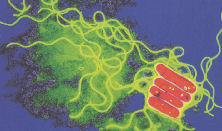
Legionella pneumophila
Legionnaires' disease is the severest form of infection caused by the bacterium Legionella pneumophila. It is the most well-known and serious form of a group of diseases known as legionellosis. Other similar (but usually less serious) conditions include Pontiac fever and Lochgoilhead fever.
Legionnaires' disease acquired its name in 1976 when an outbreak of pneumonia occurred among persons attending a convention of the American Legion in Philadelphia where 34 people died and 221 people became ill. Later, the bacterium causing the illness was isolated from lung tissue and subsequently named Legionella pneumophila.
Some people can be infected with the Legionella bacterium and have only mild symptoms or no illness at all.
Infection is caused by breathing in small droplets of water contaminated by the bacteria. The disease cannot be passed from one person to another.
Outbreaks of Legionnaires' disease receive significant media attention. However, this disease usually occurs as a single, isolated case not associated with any recognized outbreak. When outbreaks do occur, they are usually recognized in the summer and early autumn, but cases may occur year-round. About 5% to 30% of people who have Legionnaires' disease die.
Patients with Legionnaires' disease usually have fever, chills, and a cough, which may be dry or may produce sputum. Some patients also have muscle aches, headache, tiredness, loss of appetite, and, occasionally, diarrhoea. Laboratory tests may show that these patients' kidneys are not functioning properly. Chest X-rays often show pneumonia. It is difficult to distinguish Legionnaires' disease from other types of pneumonia by symptoms alone; other tests are required for diagnosis.
The time between the patient's exposure to the bacterium and the onset of illness for Legionnaires' disease is 2 to 10 days, but usually between 3 and 6 days.
People of any age may get Legionnaires' disease, but the illness in itsí severe form most often affects middle-aged and older persons, particularly those who smoke cigarettes or have chronic lung disease. Also at increased risk are persons whose immune system is suppressed by diseases such as cancer, kidney failure requiring dialysis, diabetes, or AIDS. Those that take drugs that suppress the immune system are also at higher risk.
Erythromycin is the antibiotic currently recommended for treating persons with Legionnaires' disease. In severe cases, a second drug, rifampin, may be used in addition. Other drugs are available for patients unable to tolerate erythromycin.
Outbreaks of legionellosis have occurred after persons have breathed mists that come from a water source (e.g., air conditioning cooling towers, whirlpool spas, showers) contaminated with Legionella bacteria. Persons may be exposed to these mists in homes, workplaces, hospitals, or public places. Legionellosis is not passed from person to person, and there is no evidence of persons becoming infected from vehicle air conditioners or household window air-conditioning units.
|
|

